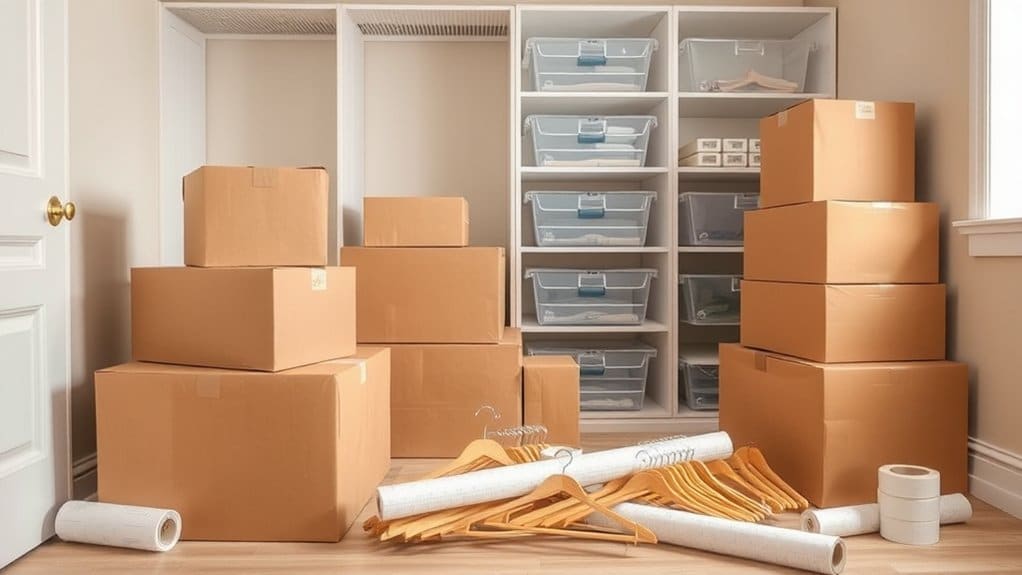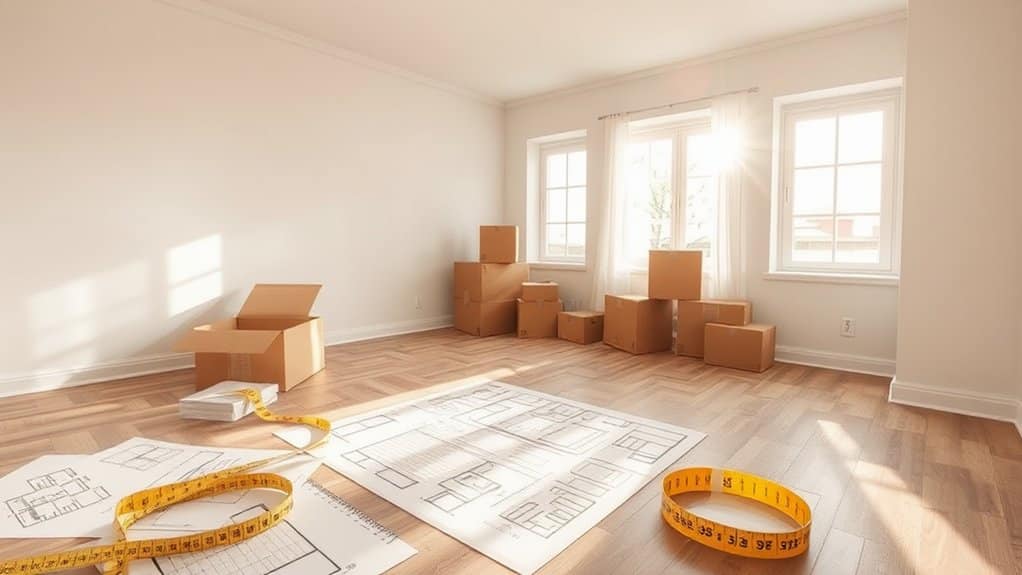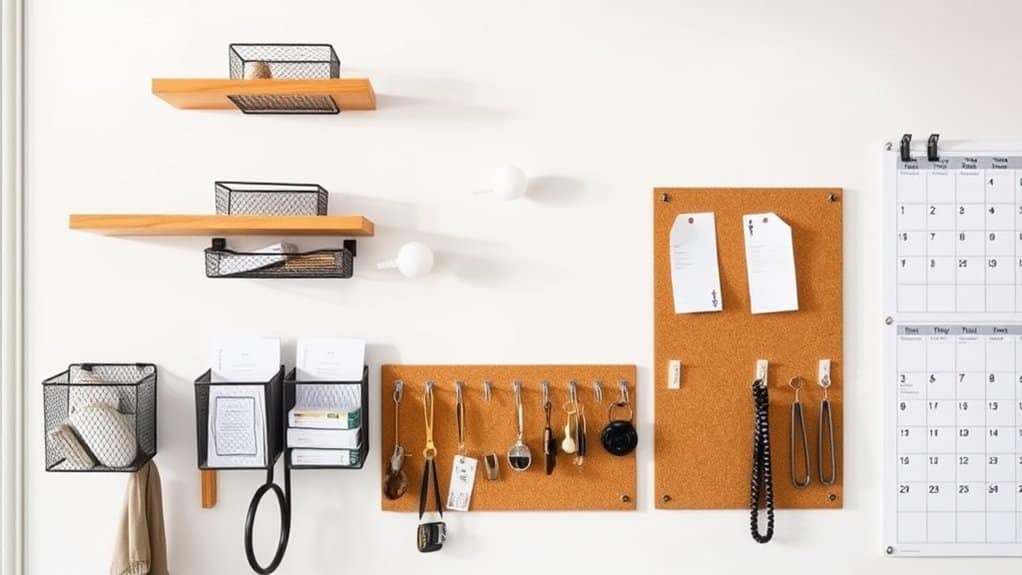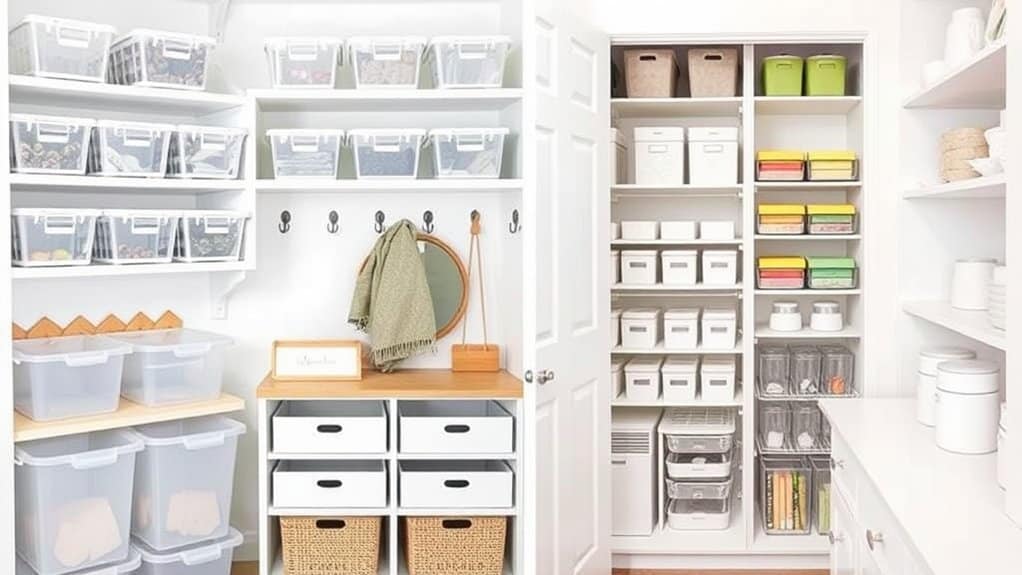When you're unpacking and organizing your new home, start by creating a detailed room-by-room checklist to guide your efforts. You'll want to unpack systematically, focusing on essential spaces like your bedroom and bathroom first. Set up your furniture to establish clear pathways, keeping 36-48 inches between pieces for easy movement. Use clear, labeled containers for storage and implement vertical solutions to maximize space. Create a command center with calendars and charging stations to manage daily tasks, and maintain a "one-in, one-out" rule to control clutter. For the smoothest changeover, you'll discover it's all about having the right organizational systems in place.
Getting Started With Your Move

When you're preparing to move into a new home, careful planning and organization are essential for a smooth changeover.
Start by creating a detailed moving checklist that covers all aspects of your relocation, from initial packing to final setup. You'll want to begin with a thorough room-by-room inventory of your belongings, deciding what to keep, sell, or donate. Keep a binder with documents ready to store important paperwork and contacts for utilities setup. Consider hiring professional movers after researching reviews and obtaining multiple quotes for comparison. Remember to compare moving companies to ensure you're making an informed choice.
Your packing strategies should focus on organizing items by category and room, using clear labels on all boxes to track contents easily. Having a designated essential items box will ensure quick access to survival necessities during the unpacking process.
Gather essential packing supplies, including bubble wrap and packing paper for fragile items, and keep important documents in a separate, secure container.
As you pack, remember to set aside daily necessities in an easily accessible bag, ensuring you'll have everything you need during the first few days in your new home.
Setting Up Essential Living Spaces
After completing the initial moving preparations, your focus should shift to creating functional living spaces in your new home.
Start by organizing your bedroom, setting up your bed and arranging closet spaces for easy access to clothing and essentials.
Next, tackle living room essentials by positioning your sofa and seating areas to create a welcoming conversation space, complemented by proper lighting and entertainment setup.
When arranging these spaces, you'll want to work systematically, unpacking one room at a time to avoid feeling overwhelmed.
Use organizational tools like drawer dividers and labels to keep items accessible, and consider multi-functional furniture to maximize your space.
Remember to position frequently used items within easy reach, and utilize vertical storage solutions like bookcases to make the most of your available space.
Establishing a daily cleaning routine will help maintain the organization of your newly arranged spaces.
A comfortable dining room table can serve multiple purposes, from family meals to workspace for various activities.
Room Layout Planning Tips

When planning your room's layout, you'll need to establish clear paths for moving between different areas while keeping furniture arrangements practical and functional.
You can create efficient traffic patterns by positioning larger pieces first and maintaining adequate walking space of 36-48 inches between furniture groups.
Your furniture placement should support the room's primary activities, whether it's conversation, entertainment, or relaxation, while making the most of available space through smart positioning and vertical storage solutions. Additionally, consider using storage solutions that can help you keep the space organized and clutter-free.
Furniture Flow Patterns
Since furniture placement can make or break a room's functionality, understanding proper flow patterns is essential for creating comfortable living spaces.
When planning your furniture arrangement, start by ensuring pathways measure 36-48 inches wide for ideal movement efficiency. You'll want to maintain 30-36 inches between major furniture pieces, while keeping coffee tables 16-18 inches from seating areas.
Your furniture layout should support natural traffic patterns and emphasize focal points like fireplaces or large windows. As you position pieces, remember to create clear pathways that don't obstruct doorways.
In busy areas like kitchens, allow 42-48 inches of space for two people to work comfortably. Keep your furniture heights consistent within groupings, and position end tables within 1-2 inches of arm height for practical accessibility. Additionally, consider strategic timing to enhance the efficiency of your moving process, which can also influence your furniture layout as you settle into your new space.
Space-Saving Design Basics
Making the most of your available space starts with smart layout planning and design principles. When you're setting up your new home, focus on creating efficient layouts that maximize every square foot while maintaining a comfortable flow.
You'll want to embrace minimalist designs that reduce clutter and enhance functionality throughout each room.
- Define specific zones within each room to create purposeful spaces that support your daily activities.
- Position furniture away from walls to create a more open, balanced atmosphere.
- Incorporate vertical storage solutions to maximize unused wall space.
- Select multifunctional furniture pieces that serve multiple purposes.
Remember to measure your rooms carefully before arranging furniture, and consider traffic patterns when planning your layout. Additionally, applying efficient packing strategies can help you systematically organize your belongings as you settle into your new space.
Smart Storage Solutions
When you're looking to maximize your new home's storage potential, start by thinking vertically with wall-mounted shelves, over-door organizers, and stackable containers that make the most of your ceiling height.
You'll find clever hidden storage opportunities in unexpected places, such as under-bed spaces, behind doors, and within furniture pieces that serve multiple purposes.
To keep your belongings organized and accessible, invest in clear, labeled containers that can adapt to different spaces, combining drawer organizers, bins, and adjustable shelving systems to create a customized storage solution that works for your specific needs. Additionally, consider utilizing short-term storage options during transitions or renovations to keep your space clutter-free.
Vertical Space Maximization Tips
After moving into your new home, maximizing vertical space becomes essential for creating an organized and clutter-free environment. Wall mounted solutions, like floating shelves and pegboards, can transform unused wall areas into functional storage spaces.
Consider incorporating vertical gardening elements to add both storage and natural beauty to your living spaces.
- Measure your walls carefully before installing any storage solutions to guarantee proper fit and functionality.
- Install adjustable shelving systems that can adapt to your changing storage needs.
- Utilize wall-mounted cabinets in bathrooms and kitchens to keep essentials off countertops.
- Create custom corner shelving units to maximize otherwise wasted space.
Remember to blend your storage solutions with your home's existing décor, choosing options that serve both practical and aesthetic purposes.
Multi-functional furniture pieces can further enhance your vertical storage strategy while maintaining a clean, organized look.
Hidden Storage Spots
Smart storage solutions often lie hidden in plain sight throughout your home.
You'll find valuable storage opportunities under your bed, where vacuum-sealed bags and clear bins can protect seasonal clothing and extra bedding.
Hidden compartments in furniture, like storage ottomans and coffee tables with built-in storage, offer convenient spots to tuck away everyday items while maintaining a clutter-free appearance.
Don't overlook spaces that might seem unusable at first glance.
The area behind cabinet doors, space above toilets, and gaps between wall studs can transform into practical storage areas.
Consider installing recessed shelving or using over-the-door organizers to maximize these overlooked spaces.
You can even repurpose vintage suitcases as decorative storage units, combining both function and style in your home organization strategy.
Multi-Purpose Container Solutions
The key to effective home organization lies in selecting versatile storage containers that serve multiple purposes. When choosing storage solutions, consider different container materials like plastic, wicker, and fabric to match your organizational aesthetics while maintaining functionality.
You'll want options that can adapt to various spaces throughout your home, making the most of your storage potential.
Here are four essential tips for maximizing multi-purpose containers:
- Select clear containers for pantry items that can later be repurposed for craft supplies.
- Use lidded bins that work equally well in closets or under-bed storage.
- Choose stackable containers that can shift between seasons and spaces.
- Invest in drawer organizers that can work in any room, from kitchen to bathroom.
Stay flexible with your storage choices, allowing them to evolve with your needs.
Command Center Organization

Creating an organized command center serves as the backbone of a well-functioning household. When setting up your command center essentials, you'll want to choose a central location that's easily accessible to all family members, such as your kitchen, mudroom, or entryway.
Command center customization should reflect your family's unique needs, incorporating elements like calendars, charging stations, and storage solutions for important papers and devices.
Start by planning your space carefully, considering what components you'll use most frequently. You'll need a mix of organizational tools, including wall-mounted calendars, dry-erase boards for messages, and designated spots for keys and mail.
Don't forget to include file organizers and bins to keep paperwork tidy, and make sure to label everything clearly for easy identification.
Decluttering During Unpacking
Moving beyond your command center setup, successful unpacking starts with a strategic decluttering approach. When you're implementing decluttering strategies, it's crucial to tackle one room at a time while sorting items into distinct categories.
Your organizing hacks should include labeling boxes clearly and using vertical storage solutions to maximize space efficiency.
- Sort items immediately into three piles: keep, donate, and discard
- Create designated zones in each room for efficient unpacking
- Utilize post-it notes to plan item placement before unpacking
- Set up storage solutions like shelves and bins as you go
Remember to break down boxes as you empty them, and maintain a donation box nearby for items you no longer need.
This systematic approach will help you create an organized, clutter-free space while making the unpacking process more manageable and efficient.
Systems for Daily Organization

Once you've completed the initial unpacking phase, maintaining an organized home requires implementing reliable daily systems.
You'll want to create daily checklists that outline specific times for routine tasks, including tidying up, meal planning, and household chores. Keep a storage inventory to track where items are located, using clear labeling systems and storage solutions that maximize both horizontal and vertical space.
To maintain long-term organization, establish morning and evening routines that involve the whole family. You can assign specific tasks to family members and use organizational apps to keep everyone on track.
Remember to implement the "one-in, one-out" rule to prevent clutter buildup, and schedule regular reviews of your organizational systems to guarantee they're still meeting your household's needs.
Creating Functional Living Areas
To establish functional living areas that work for your lifestyle, start by arranging furniture to create natural pathways and comfortable conversation zones throughout each room.
Through effective functional zoning, you'll make each space more purposeful while ensuring lifestyle adaptability as your needs change.
- Define distinct areas using strategically placed rugs and furniture arrangements, creating clear boundaries between living, dining, and work spaces.
- Incorporate multiple lighting sources, including pendant lights and table lamps, to enhance both ambiance and functionality.
- Maximize vertical storage with shelving units and bookcases to keep frequently used items within easy reach.
- Choose versatile, multi-functional furniture pieces like storage ottomans and sofa beds that can adapt to different uses throughout the day.
Remember to maintain clear pathways between zones while ensuring each area serves its intended purpose effectively.
Conclusion
Studies show that the average American moves 11.7 times in their lifetime, making organization skills essential for your future. When you've followed these unpacking and organizing strategies, you'll find your new home feels settled and functional. By establishing smart storage solutions, maintaining your command center, and creating purposeful spaces, you've built a foundation for an organized lifestyle. Your efforts will continue to pay off as you enjoy your well-structured living space.


